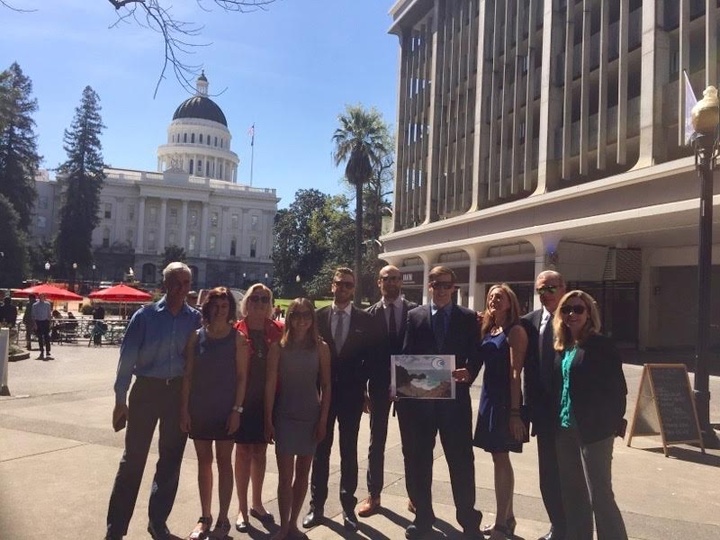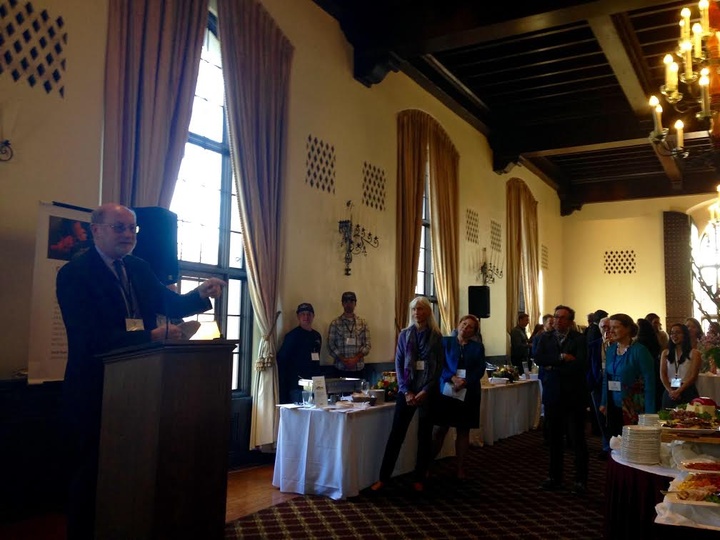
Surfrider chapter members spent a day far from the ocean | Photos: DBK
The California State Capitol is far from the coast, but decisions and laws forged there have large impacts on the future of the coast and ocean. That is why Ocean Day has been bringing advocates to the State Capitol to discuss important ocean issues with state legislators since 2005. This event continues to educate legislators on the most up-to-date issues and events concerning our oceans and how they keep California beautiful.
Tuesday, March 14 was the twelfth and by far the largest Ocean Day to date. Nearly 100 attendees from all over the state participated and held over 90 meetings with legislators. Participants and organizers represented a variety of groups such as AZUL, Environment California, Surfrider Foundation, California Coastkeeper Alliance, CSU COAST, Ocean Conservancy, Monterey Bay Aquarium, Natural Resources Defense Council, Heal the Bay, 7th Generation Advisors, California Coastal Coalition, Clean Seas Coalition, Unite Here, COARE, Blue Frontier. This year advocates focused on ensuring the success of our marine protected areas, making our ocean accessible for all Californians, as well as helping to protect the coast from the harmful effects of industrialization.

CCC Executive Director Jack Ainsworth welcomes ocean enthusiasts
The day started with a welcome ceremony featuring opening remarks by new Executive Director of the Coastal Commission Jack Ainsworth. Ainsworth expressed his support and dedication to the coast stating, “I am going to be there to fight for coastal protection. Keep up the good fight.”
Throughout the day, advocates held meetings with members of the California State Senate and Assembly, and their staff, to discuss current ocean issues and urge the members’ direct action on upcoming bills.
“Ocean day is an event that I look forward to each year and believe is vital to help protect California’s coastline,” said Madison Peters, Coastal Programs Coordinator for the Northcoast Environmental Center. “Not only is it a wonderful day where we get to meet up with our fellow environmentalists from all over the state, it’s a chance to try and make a difference and get our voices heard with our representatives,” said Peters.

Secretary John Laird speaks
To celebrate the day, the Monterey Bay Aquarium hosted a reception featuring sustainable seafood and honoring those who have helped to advance ocean health in our state. Secretary of the California Natural Resources Agency John Laird gave the opening speech, expressing his gratitude for everyone who dedicates their career to protecting the future of our oceans.
Not able to make it to Ocean Day? There are many chances be an ocean advocate and make your voice heard!
Support for critical funding for the Environmental Protection Agency (EPA) and National Oceanic and Atmospheric Administration (NOAA) is needed so these agencies can fulfill their mandates related to clean water, public health, and management of our nation’s ocean and coast. Presidents Trump’s first federal budget proposal for fiscal year 2018 was recently released, and includes a 31% reduction to the EPA’s budget and the elimination of 3,200 staff positions, and a 16% reduction to the Department of Commerce, much of that targeted at NOAA. These proposed cuts would undermine the ability of both agencies to protect vital public resources that support our nation’s coastal communities and economies.
Several programs that are not included in the President’s budget and need your support are;
- EPA’s BEACH Grants Program provides federal assistance to coastal states and territories to monitor water quality at beaches and to notify the public when bacteria levels exceed health standards. Elimination of EPA’s BEACH Grant Program will not only leave beachgoers at risk, but also threaten our nation’s coastal recreation and tourism sector valued at over $100 billion by the National Ocean and Economics Program.
- NOAA’s Coastal Zone Management Program authorized by the Coastal Zone Management Act (CZMA). The program achieves multiple goals for states and coastal communities including economic development, enhancement of public access and recreation, and protection of coastal resources. The program provides the basis for protecting, restoring, and responsibly developing our nation’s diverse coastal communities and resources. Moreover, the CZMA requires a dollar-for- dollar state match for almost all federal funding, with states matching over $59 million FY2016.
- NOAA’s Coastal Resilience Program, which provides tools and resources for communities to address the impacts of extreme weather and climate-related hazards. This includes support for projects that protect life and property, safeguard people and infrastructure, strengthen the economy, and conserve and restore coastal and marine resources. The program has also supported regional ocean planning to ensure a coordinated approach to the development and conservation of our marine ecosystems.
- NOAA’s Sea Grant Program, which encompasses a network of 33 programs located in US States and territories. These programs engage over 300 institutions involving more than 3,000 scientists, engineers, educators, students and outreach experts to to provide integrated research, communication, education, extension and legal programs to coastal communities that lead to the responsible use of the nation’s ocean, coastal and Great Lakes resources.
What can you do?
Call or email your Congressional Representatives in DC and remind them that its their responsibility to ensure that the EPA and NOAA are empowered, through adequate funding, staffing and authority, to continue to meet each mission.
CLICK TO MANAGE